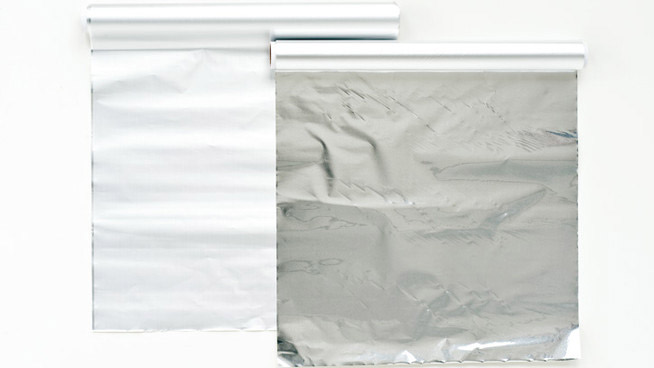Shiny or dull side?
Aluminum foil is manufactured by a rolling process. A sheet of aluminum about 1 cm thick is flattened by passing several times between the cylinders of a rolling mill, until the desired thickness is reached. In the final rolling step, two layers of foil are passed through the rolling mill at the same time. This technique results in a difference in the level of shine: the friction of the inner sides of the layers against each other produces a matte or dull side, while contact with the mill’s highly polished steel rollers produces a glossy or shiny side. The difference in appearance is therefore not intended: it is simply a manufacturing quirk! There’s an urban myth out there that says the shiny side reflects more heat that the matte side and therefore which side you use has an effect on cooking. It’s not true and here’s the proof!
The explanation
During cooking, heat is transferred to food by a combination of three ways: by conduction (direct contact between food and a hot surface), by convection (hot air or liquid circulation around a food) and, finally, by thermal radiation. It is mainly thermal radiation that comes into play when cooking in the oven or on the barbecue. When hot, the heating element of the oven, grill or charcoal in the barbecue all emit thermal radiation. These invisible infrared waves can reflect off shiny surfaces, such as that of aluminum foil, which can have a slowing effect. But the shine difference between the dull and glossy sides of aluminum foil is not large enough to make a difference. The food inside will take the same time to cook, regardless of which side of the foil it touches.
Result
The experiment was conclusive: the temperature of food rose at the same rate whether the shiny side was on the inside or outside. What about cooling? Did placing the shiny side on the inside help retain heat in the papillote after cooking? Not at all! The temperature inside the papillote fell at the same rate after being removed from the oven.
Tip
No more sticking
We love potatoes cooked in foil on the barbecue. The only downside? They mercilessly stick to even well-oiled aluminum foil. Our solution? Add a sheet of parchment paper underneath the sheet of aluminum foil. The parchment paper forms a barrier that prevents food from sticking and allows for more uniform cooking. A sure fire trick!

